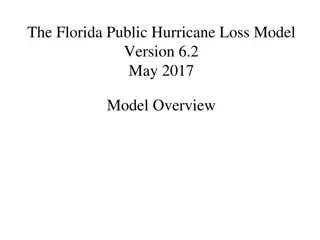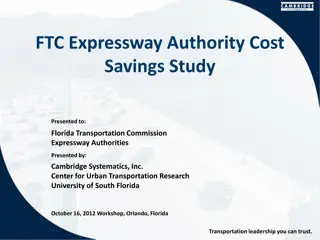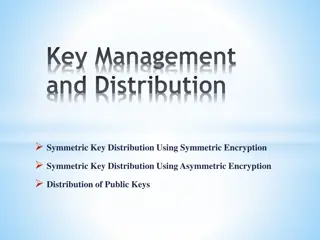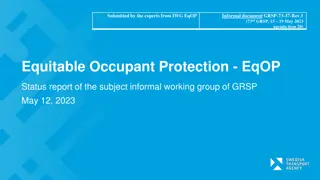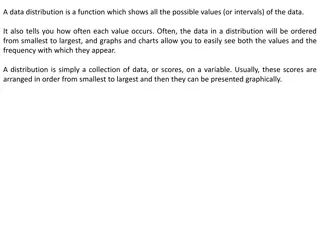Understanding Equitable Distribution in Florida
Equitable distribution in Florida, governed by statutes 61.075 and 61.076, determines the fair division of marital assets and liabilities in divorce cases. Key considerations include identification, valuation, distribution presumption, and justification for unequal distribution. Assets are classified as marital or nonmarital based on specific criteria, with a rebuttable presumption for assets acquired during the marriage. Future earnings generally are not considered marital assets.
Download Presentation

Please find below an Image/Link to download the presentation.
The content on the website is provided AS IS for your information and personal use only. It may not be sold, licensed, or shared on other websites without obtaining consent from the author. Download presentation by click this link. If you encounter any issues during the download, it is possible that the publisher has removed the file from their server.
E N D
Presentation Transcript
Equitable Distribution 61.075, Florida Statutes
Four Basic Considerations: 1. Identification: of marital or non-marital 2. Valuation: When? Separation? Filing? Trial? 2. Distribution: Presumption in favor of equal (in value) distribution of marital assets and liabilities 3. Justification of unequal distribution, if any: If unequal distribution, requires justification based on the statutory factors set out in 61.075(1)(a) through (j) (e.g. duration of marriage, dissipation, etc.)
Is it marital? 61.075(6)(a) defines what is marital: 1. Assets and liabilities acquired during the marriage 2. Enhancement in value and appreciation of non- marital assets resulting from marital efforts or marital expenditures BUT SEE Kaaa v. Kaaa 3. Interspousal gifts during the marriage (can only be overcome by clear and convincing evidence) 4. Vested and nonvested benefits in retirement, pensions, etc. 5. All real property held by the entireties, whether acquired before or after the marriage (rebuttable presumption)
Presumption of Marital 61.076(8) establishes a rebuttable presumption that assets acquired and liabilities incurred subsequent to the date of the marriage are marital. Presumption can be overcome by showing that the assets and liabilities are nonmarital Burden is on the spouse claiming it is nonmarital.
Is it nonmarital? 61.075(6)(b) defines what is nonmarital: 1. Assets acquired and liabilities incurred prior to the marriage or in exchange for such assets and liabilities 2. Assets acquired separately by noninterspousal gift, bequest, devise, or descent or in exchange for such assets. 3. All income derived from nonmarital assets unless the income was treated, used, or relied upon by the parties as a marital asset. 4. Assets and liabilities excluded by prenup. 5. Bad behavior liability unless ratified by other spouse
Is it nonmarital? To the extent that a party incurred debts to cover nonmarital expenses, the debt should not be classified as marital debt. Fortune v. Fortune, 61 So.d 441 (Fla. 2d DCA 2011) A gift of a motel to the wife who worked there during the marriage was nonmarital, BUT any appreciation in its value was marital. Wilson v. Wilson, 992 So.2d 395 (Fla. 1stDCA 2008)
What about future earnings? Generally, a spouse s future earning ability is not an asset for purposes of equitable distribution because it does not accrue during the marriage. Barner v. Barner, 716 So.2d 795 (Fla. 4thDCA 1998) BUT SEE: Dye v. Dye, 17 So.3d 34 (Fla. 2d DCA 2009) where value of unused sick and vacation days was subject to equitable distribution. AND WHAT ABOUT: Valentine v. Valentine, 137 So.3d 566 (Fla. 3d DCA 2014) Wife s future potential book about her sister s death potentially marital portion to it?
Carnicella v. Carnicella 140 So.3d 697 (Fla. 5thDCA 2014) Interesting case with a few problems: Oral ruling by judge, but 6-month delay in entry of final judgment Verbatim adoption of Wife s proposed final judgment Final judgment conflicted with oral ruling (e.g. denied both parties attorney s fees, but found Wife s debt of $30,000, which she used to pay her attorney, a marital liability) Holding: The delay alone does not require reversal, but delay plus indication that something is seriously amiss on the merits does.
Date is Important! Assets acquired before marriage are nonmarital assets and remain the property of the owner spouse in the absence of evidence of a gift or conveyance to the owner s spouse. Moss v. Moss, 829 So.2d 302 (Fla. 5thDCA 2002) Property acquired during the marriage through the exchange of nonmarital assets is nonmarital. Beaty v. Gribble, 652 So.2d 1156 (Fla. 2d DCA 1995)
Date is Important! Cut-off date for identifying marital assets and liabilities is earliest of entering into a valid separation agreement* or filing petition for dissolution of marriage 61.075(7) ; Wagner v. Wagner, 136 So.3d 718 (Fla. 2d DCA 2014) BUT SEE: Santiago v. Santiago, 51 So.3d 637 (Fla. 2d DCA 2011) (court may consider intentional waste or depletion to do equity) *Separation agreement as to financial matters does not require court ratification or approval.
Valuation Date of Marital Assets The trial court will have more discretion on the date for purposes of valuation as compared to identification as marital or nonmarital. 61.075(7), the court has discretion to determine a date that is just and equitable for valuation purposes. This means different assets may be valued at different dates in the judge s discretion as the circumstances require. It s done on a case-by-case basis and no presumption of a particular date exists.
Valuation Date of Marital Assets Essentially have three dates to choose from: 1. Separation date 2. Petition date 3. Trial date In making decision, courts examine whether one party s actions were responsible for the increase or decrease in value of, or even the existence of, the asset in question, subsequent to the date of separation or date of petition. Active efforts of one party results in increase=Separation or petition date Passive or market forces=Trial date
Cut-off vs. Valuation In summary: Cut-off date: Determines if marital vs. nonmarital Brightline Valuation date: No presumption of date- separation, petition or trial Determines when it should be valued after determining it s marital Passive vs. active
From Nonmarital to Marital Nonmarital property may become marital under the following circumstances: 1. Commingling: When the nonmarital assets are commingled with marital assets. 2. Enhancement of Value: 61.075(6)(a)1.b. a nonmarital asset may be altered into a marital asset to the extent that its value has been enhanced by marital funds or labor. Also see Kaaa v. Kaaa, 58 So.3d 867 (Fla. 2010)
Kaaa v. Kaaa 58 So.3d 867 (Fla. 2010) When a marital home constitutes nonmarital real property, but is encumbered by a mortgage marital funds service, the value of the passive, market- driven appreciation of the property that accrues during the course of a marriage is a marital asset subject to equitable distribution.
Kaaa v. Kaaa 58 So.3d 867 (Fla. 2010) In the absence of improvements, the portion of the appreciated value of a separate (i.e. nonmarital) asset which should be treated as a marital asset will be the same as the fraction calculated by dividing the indebtedness with which the asset was encumbered at the time of the marriage by the value of the asset at the time of the marriage.
Kaaa v. Kaaa 58 So.3d 867 (Fla. 2010) In Kaaa analysis, trial court must do the following: 1.Determine the overall fair market value of the home. 2. Determine whether there has been passive appreciation in the home s value. 3. Determine whether the passive appreciation is marital. This requires specific findings of fact that marital funds were used to pay the mortgage, that the nonowner spouse made contributions to the property, and to what extent the contributions of the nonowner spouse affected the appreciation of the property. 4. Determine the value of the passive appreciation that accrued during the marriage and is subject to equitable distribution. 5. Determine allocation of the value.
Kaaa v. Kaaa 58 So.3d 867 (Fla. 2010) What does this look like? Mortgage at time of marriage is $34,500 FMV of home at time of marriage is $36,500 Current FMV of home is $225,000 $34,500/$36,500 = 94.5% 94.5% x $174,100 (210,600* 36,500) = $164,524 active appreciation *$210,600 because $14,400 from carport.
Unequal Distribution 61.075(1) starts out with presumption of equal distribution, but sets out factors to consider for unequal distribution: (a) The contribution to the marriage by each spouse, including contributions to the care and education of the children and services as homemaker; (b) The economic circumstances of the parites; (c) The duration of the marriage;
Unequal Distribution (d) Any interruption of personal careers or educational opportunities of either party; (e) The contribution of one spouse to the personal career or educational opportunity of the other spouse; (f) The desirability of retaining any asset, including an interest in a business, corporation or professional practice, intact and free from any claim or interference by the other party;
Unequal Distribution (g) The contribution of each spouse to the acquisition, enhancement, and production of income or the improvement of, or the incurring of liabilities to, both the marital assets and the nonmarital assets of the parties; (h) The desirability of retaining the marital home as a residence for any dependent child of the marriage, or any other party, when it would be equitable to do so, it is in the best interest of the child or that party, and it is financially feasible for the parties to maintain the residence until the child is emancipated or until exclusive possession is otherwise terminated by a court of competent jurisdiction;
Unequal Distribution (i) The intentional dissipation, waste, depletion, or destruction of marital assets after the filing of the petition or within 2 years prior to the filing of the petition; (j) Any other factors necessary to do equity and justice between the parties
Enforcement It is well-settled that contempt does not lie to enforce a property settlement arising out of a dissolution of marriage. Randall v. Randall, 948 So.2d 71 (Fla. 3d DCA 2007)
Practice Tips It is reversible error not to identify and value all assets and provide a basis for distribution. Trial court must make specific factual findings ascribing a value to each marital asset and liability. Any unequal distribution requires specific findings of facts that justify the unequal distribution. Get into the habit of adding as of dates to Financial Affidavit. Include Equitable Distribution Chart which identifies all assets and liabilities as marital or nonmarital, valuation, date of valuation, and distribution. Attach to Final Judgment.



